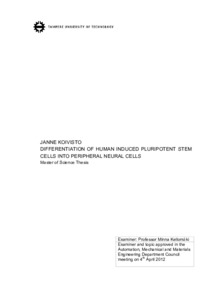Differentiation of human induced pluripotent stem cells into peripheral neural cells
Koivisto, Janne (2013)
Koivisto, Janne
2013
Materiaalitekniikan koulutusohjelma
Tieto- ja sähkötekniikan tiedekunta - Faculty of Computing and Electrical Engineering
This publication is copyrighted. You may download, display and print it for Your own personal use. Commercial use is prohibited.
Hyväksymispäivämäärä
2013-02-06
Julkaisun pysyvä osoite on
https://urn.fi/URN:NBN:fi:tty-201302221072
https://urn.fi/URN:NBN:fi:tty-201302221072
Tiivistelmä
The development of human peripheral nervous system is not as well known on the cellular level as the central nervous system, but during the last few years there have been published cell culture protocols that can produce peripheral sensory neural cells. Changing pluripotent stem cells into some specific cell type is called differentiation. Differentiating cells in laboratory can produce them for applications such as drug and toxicology screening, modeling diseases on cellular level or for use in clinical applications in medicine. The peripheral sensory neurons, such as unmyelinated C nerve fibers that are responsible for sense of pain are good targets for drug development and disease models.
The differentiation protocols work for human embryonic stem cells, but when this thesis was started, no data about the use of induced pluripotent stem cells, or iPS cells, for peripheral neural differentiation were published yet. The most important aim of this thesis was to prove that peripheral sensory neurons can be produced from iPS cells with this protocol. The nature of differentiated cells was studied according to morphology and phenotype by protein expression studies in immunocytochemistry and RT-PCR and functionality was studies by calcium-imaging.
In addition to cell differentiation, the extracellular matrix protein coatings used as cell culture surface, were studied as well. The aim was to find the best out of four coatings suitable for peripheral neurons and study the physical differences of these coatings. The studied coatings were laminin, fibronectin, Matrigel™ and gelatin. Coatings were studied by atom force microscopy, contact angle measurement from liquid-solid interface and antibody based fluorescence labeling.
It was possible to differentiate neural cells that have calcium signaling, with the protocol selected for the thesis, but the differentiation efficiency varied a lot. Cells with general neural morphology and functioning calcium signaling were produced, but more specifically C-fiber-like peripheral sensory neurons were only detected in very small amounts and their nature was uncertain. Out of the studied protein coatings, laminin seemed better than the others, but the difference especially in cell culturing was not big, except for two occasions. In the future the differentiation of these kinds of cells should be done with a new protocol published after starting this thesis, and use the analysis methods learned from this thesis to evaluate the differentiation results of the newer protocol.
The differentiation protocols work for human embryonic stem cells, but when this thesis was started, no data about the use of induced pluripotent stem cells, or iPS cells, for peripheral neural differentiation were published yet. The most important aim of this thesis was to prove that peripheral sensory neurons can be produced from iPS cells with this protocol. The nature of differentiated cells was studied according to morphology and phenotype by protein expression studies in immunocytochemistry and RT-PCR and functionality was studies by calcium-imaging.
In addition to cell differentiation, the extracellular matrix protein coatings used as cell culture surface, were studied as well. The aim was to find the best out of four coatings suitable for peripheral neurons and study the physical differences of these coatings. The studied coatings were laminin, fibronectin, Matrigel™ and gelatin. Coatings were studied by atom force microscopy, contact angle measurement from liquid-solid interface and antibody based fluorescence labeling.
It was possible to differentiate neural cells that have calcium signaling, with the protocol selected for the thesis, but the differentiation efficiency varied a lot. Cells with general neural morphology and functioning calcium signaling were produced, but more specifically C-fiber-like peripheral sensory neurons were only detected in very small amounts and their nature was uncertain. Out of the studied protein coatings, laminin seemed better than the others, but the difference especially in cell culturing was not big, except for two occasions. In the future the differentiation of these kinds of cells should be done with a new protocol published after starting this thesis, and use the analysis methods learned from this thesis to evaluate the differentiation results of the newer protocol.
